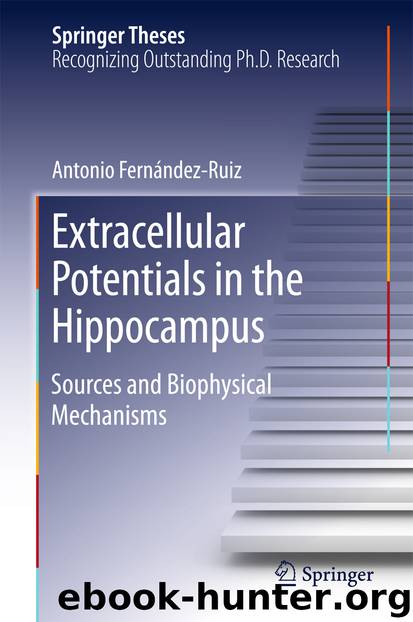Extracellular Potentials in the Hippocampus by Antonio Fernández Ruiz

Author:Antonio Fernández Ruiz
Language: eng
Format: epub
Publisher: Springer International Publishing, Cham
3.1.2 DentateGyrus
Despite the fact that LFPs in dentate gyrus have been much less intensively researched than in the CA1 region, it has been know for long time that this structure exhibits a rich variety of LFP patterns and oscillations, including theta and gamma rhythms [5], dentate spikes [6], slow oscillations [26] and odor-evoked beta oscillations [24]. However, due to the complexity of its local circuits and the scarce knowledge regarding the synaptic inputs and firing properties of its different cell types during behavior, the mechanisms of generation of the different LFP patters observed in the DG remain largely unknown. It has been shown that DG theta and gamma oscillations are strongly modulated during exploratory and learning behavior in rodents [13, 21, 34, 40], pointing towards an important function of these rhythms in cognitive functions involving this structure. DG oscillatory dynamics also has a strong impact on its main target region, CA3, [2, 36, 37] and the computations performed in the whole hippocampal circuit [34, 41].
There are two main extrinsic afferences to the DG, the medial (MPP) and the lateral (LPP) perforant paths originating in layer 2 of medial and lateral entorhinal cortex and innervating the distal and middle thirds of granular cell (GC) dendrites. So is to be expected that these two inputs are major contributors to DG LFPs. However, there are many others inputs that can also contribute substantially. On one hand, the associational-commissural fibers innervate the inner third of GC dendrites and on the other the multitude of GC layer and hilar interneurons innervate the soma and dendritic regions of the GCs.
Following the same procedure as that previously described for the CA1 LFPs, we identify three main ICs in the DG. The three ICs have similar voltage loadings, with a plateau-like maximum between cell layers throughout the hilus, which declined outwardly and reversed its polarity at different points, and characteristics points for each of them (Fig. 3.3b). The CSD loading shows more differences between ICs.
Fig. 3.3 a Similar LFP profile as illustrated in Fig. 3.2 but featuring a characteristic DG LFP pattern, dentate spikes (red arrow). b Three main ICs were found for DG LFPs. All of them display large positive voltage across the hilus but reverse polarity at different depths in the str. moleculare. Largest currents were restricted to the outer third of the str. moleculare (LPP), middle third (MPP) and GC layer (GCsom). c 2D voltage distributions for the three ICs were dominated for the positive hilar potentials but the CSD maps illustrated their different laminar specificity
Download
This site does not store any files on its server. We only index and link to content provided by other sites. Please contact the content providers to delete copyright contents if any and email us, we'll remove relevant links or contents immediately.
| Administration & Medicine Economics | Allied Health Professions |
| Basic Sciences | Dentistry |
| History | Medical Informatics |
| Medicine | Nursing |
| Pharmacology | Psychology |
| Research | Veterinary Medicine |
Periodization Training for Sports by Tudor Bompa(7929)
Why We Sleep: Unlocking the Power of Sleep and Dreams by Matthew Walker(6363)
Paper Towns by Green John(4805)
The Immortal Life of Henrietta Lacks by Rebecca Skloot(4262)
The Sports Rules Book by Human Kinetics(4079)
Dynamic Alignment Through Imagery by Eric Franklin(3925)
ACSM's Complete Guide to Fitness & Health by ACSM(3827)
Kaplan MCAT Organic Chemistry Review: Created for MCAT 2015 (Kaplan Test Prep) by Kaplan(3805)
Introduction to Kinesiology by Shirl J. Hoffman(3629)
Livewired by David Eagleman(3535)
The River of Consciousness by Oliver Sacks(3421)
The Death of the Heart by Elizabeth Bowen(3342)
Alchemy and Alchemists by C. J. S. Thompson(3298)
Descartes' Error by Antonio Damasio(3168)
Bad Pharma by Ben Goldacre(3102)
The Emperor of All Maladies: A Biography of Cancer by Siddhartha Mukherjee(2934)
The Gene: An Intimate History by Siddhartha Mukherjee(2929)
The Fate of Rome: Climate, Disease, and the End of an Empire (The Princeton History of the Ancient World) by Kyle Harper(2878)
Kaplan MCAT Behavioral Sciences Review: Created for MCAT 2015 (Kaplan Test Prep) by Kaplan(2823)
